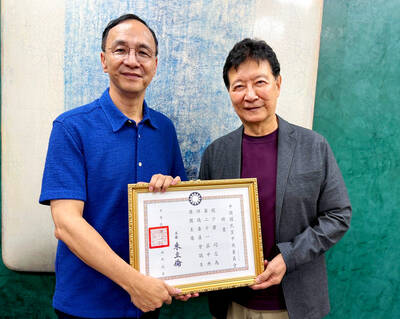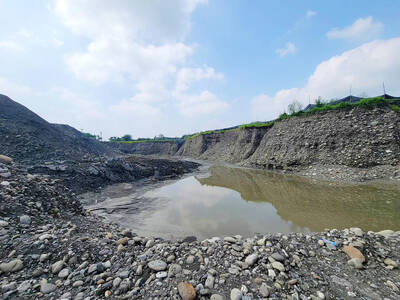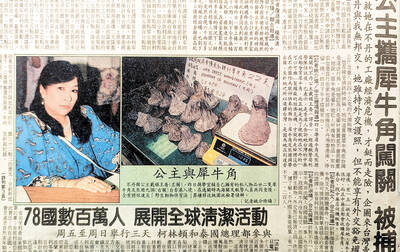All 12 animals of the Chinese Zodiac are considered equally auspicious, but one might say that some are more equally auspicious than others. An unstated preference can be generalized as: Four legs good; no legs bad.
Last year, during the supremely auspicious Year of the Dragon, the birth rate in Taiwan jumped by about 10 percent over the average annual birth rate. Presumably, this year will see fewer babies as families worked hard to squeeze in births last year and since this is the far less remarkable Year of the Snake.
The snake, the sixth sign of the zodiac, may be "equally auspicious," but in traditional Chinese culture the snake is grouped with the "Five Poisonous Creatures" (
One of the most widely known folk tales and popular Chinese operas, The White Snake (
In Buddhist philosophy, snakes, pigs and roosters represent humankind's three cardinal faults that prevent attainment of one's Buddha-nature -- hatred, greed and delusion, respectively.
Go to a Buddhist temple in Taiwan and you will see four Deva gods guarding the entrance. One has a snake wrapped around his arm to devour evil enemies and other undesirable visitors. Of the three other gods, one bears a sword, while the other two try to look menacing with a stringed musical instrument and an umbrella.
The snake in Chinese language is also used to evoke generally negative or evil ideas. For example, to call someone hypocritical in Chinese, one says they have "the mouth of Buddha and the heart of a serpent" (佛口蛇心). Extremely greedy people are like "a snake swallowing an elephant" (蛇吞象), and when wise people mix with the unwise, it is described as "dragons and snakes mingling" (龍蛇混雜).
While the Chinese language has little good to say about snakes, the creation myth of Taiwan's Paiwan (
The mythical progenitors of today's Han Chinese, Fu-xi (
The snake's consignment as a symbol of evil and negative aspects of life was more likely a consequence of humankind's irrational fear, associating snakes with the potentially lethal bite of the poisonous varieties of the reptile.
There are some 10 species of poisonous terrestrial snake in Taiwan, though not all can kill an adult human. By far the most fearsome is the 100 Pace Snake (
Taipei urbanites' closest encounters with a snake may be a trip to the famous (or infamous) Snake Alley (
And finally, in Taiwan, some believe that dreams of a snake portend a loss of wealth, while others believe a dream of a white snake heralds the birth of a son and a dream of a black snake heralds a daughter.

Next week, candidates will officially register to run for chair of the Chinese Nationalist Party (KMT). By the end of Friday, we will know who has registered for the Oct. 18 election. The number of declared candidates has been fluctuating daily. Some candidates registering may be disqualified, so the final list may be in flux for weeks. The list of likely candidates ranges from deep blue to deeper blue to deepest blue, bordering on red (pro-Chinese Communist Party, CCP). Unless current Chairman Eric Chu (朱立倫) can be convinced to run for re-election, the party looks likely to shift towards more hardline

Last week the story of the giant illegal crater dug in Kaohsiung’s Meinong District (美濃) emerged into the public consciousness. The site was used for sand and gravel extraction, and then filled with construction waste. Locals referred to it sardonically as the “Meinong Grand Canyon,” according to media reports, because it was 2 hectares in length and 10 meters deep. The land involved included both state-owned and local farm land. Local media said that the site had generated NT$300 million in profits, against fines of a few million and the loss of some excavators. OFFICIAL CORRUPTION? The site had been seized

Sept. 15 to Sept. 21 A Bhutanese princess caught at Taoyuan Airport with 22 rhino horns — worth about NT$31 million today — might have been just another curious front-page story. But the Sept. 17, 1993 incident came at a sensitive moment. Taiwan, dubbed “Die-wan” by the British conservationist group Environmental Investigation Agency (EIA), was under international fire for being a major hub for rhino horn. Just 10 days earlier, US secretary of the interior Bruce Babbitt had recommended sanctions against Taiwan for its “failure to end its participation in rhinoceros horn trade.” Even though Taiwan had restricted imports since 1985 and enacted

Enter the Dragon 13 will bring Taiwan’s first taste of Dirty Boxing Sunday at Taipei Gymnasium, one highlight of a mixed-rules card blending new formats with traditional MMA. The undercard starts at 10:30am, with the main card beginning at 4pm. Tickets are NT$1,200. Dirty Boxing is a US-born ruleset popularized by fighters Mike Perry and Jon Jones as an alternative to boxing. The format has gained traction overseas, with its inaugural championship streamed free to millions on YouTube, Facebook and Instagram. Taiwan’s version allows punches and elbows with clinch striking, but bans kicks, knees and takedowns. The rules are stricter than the